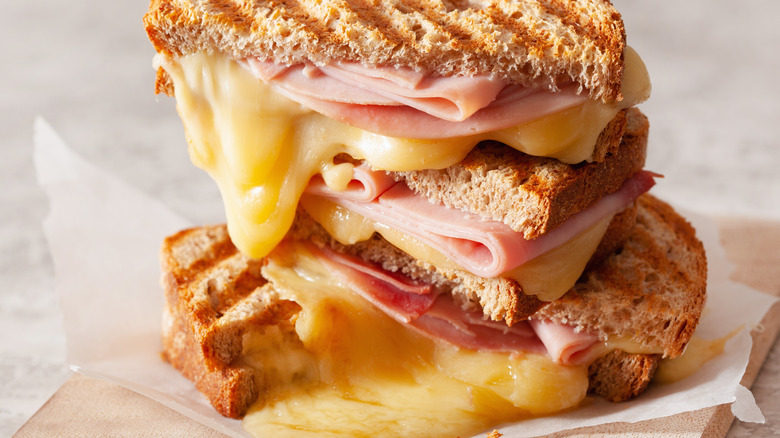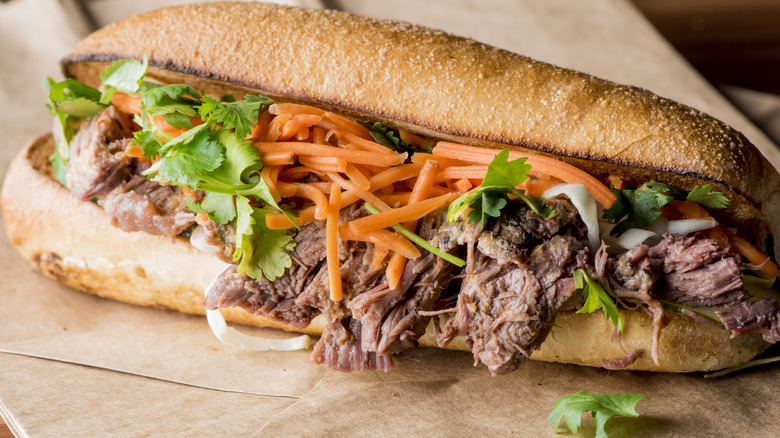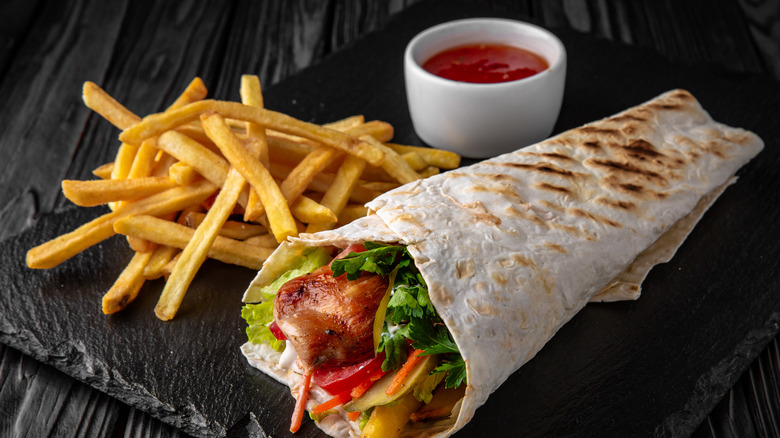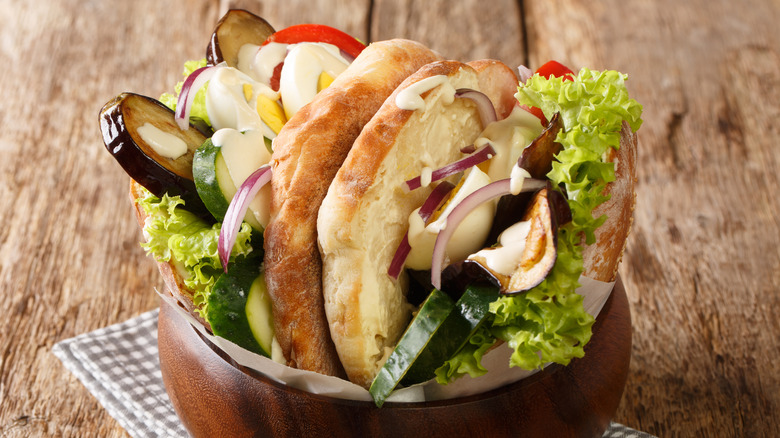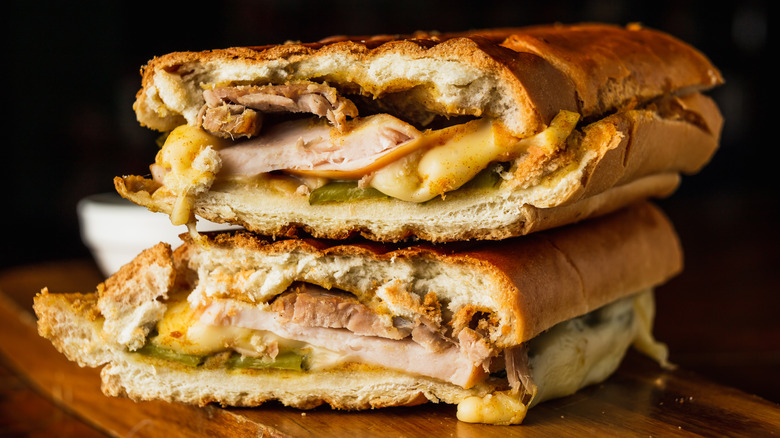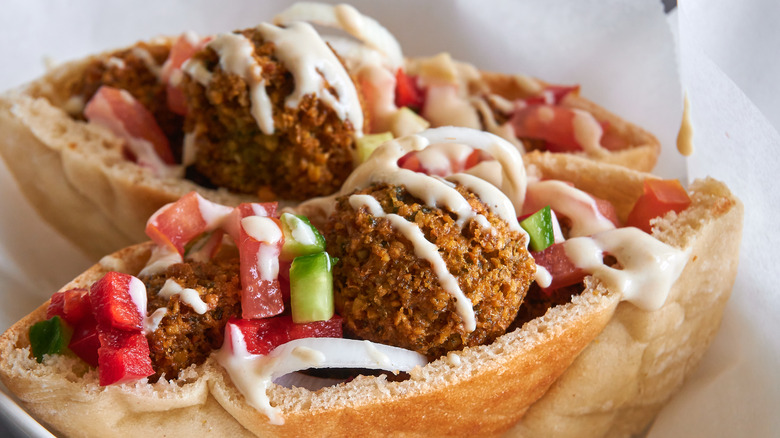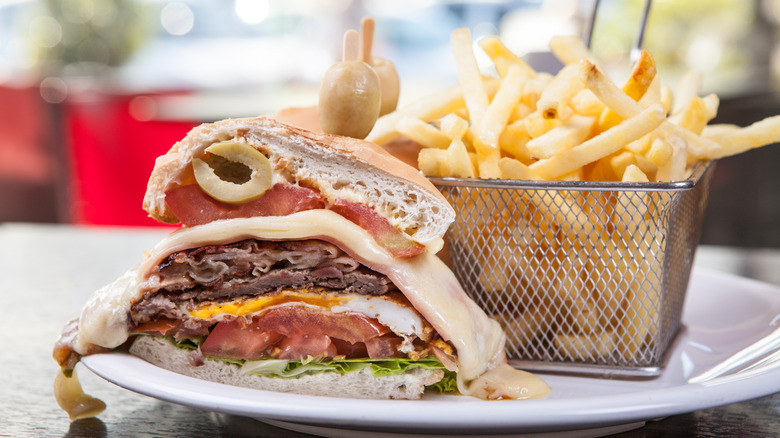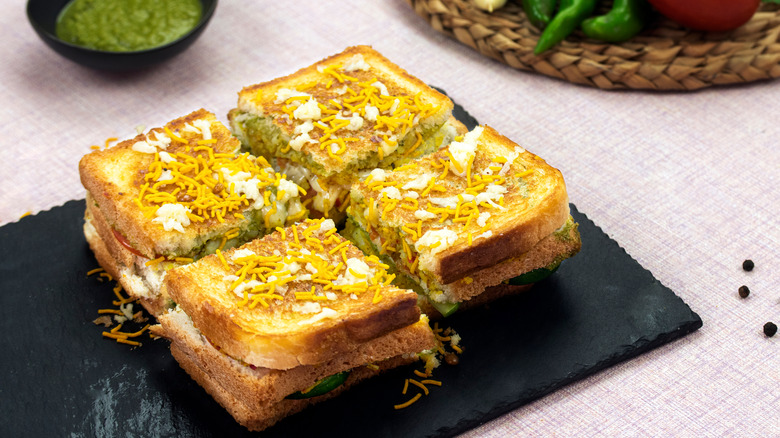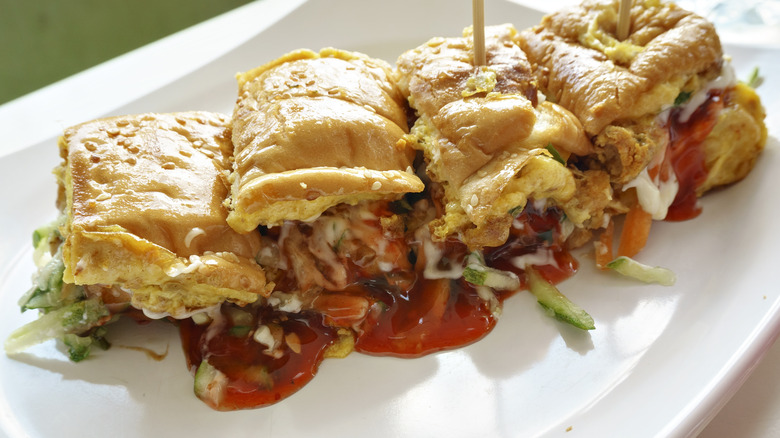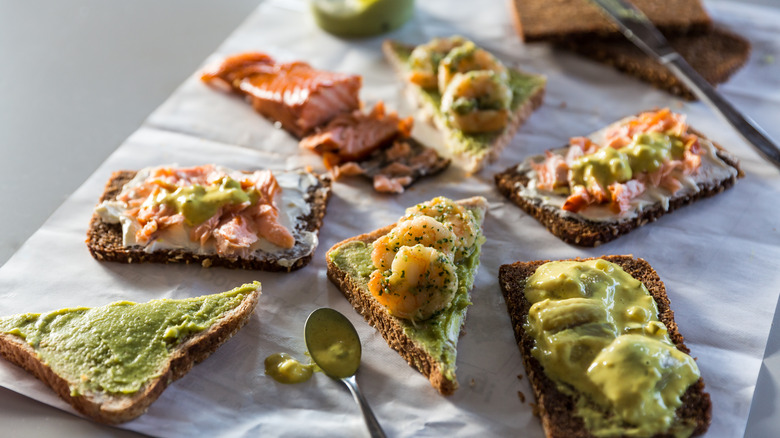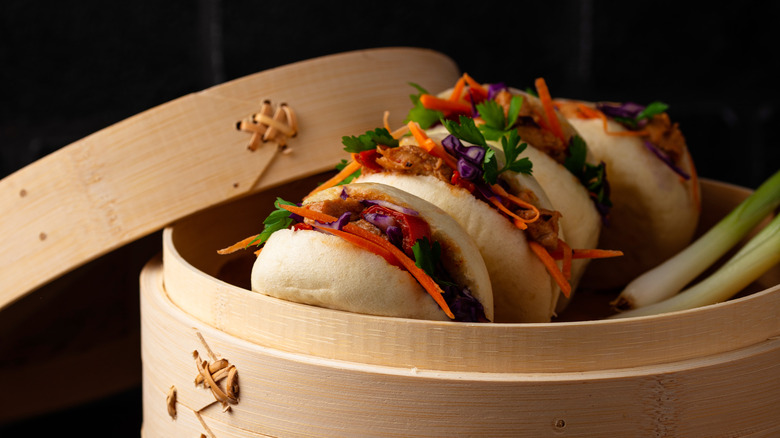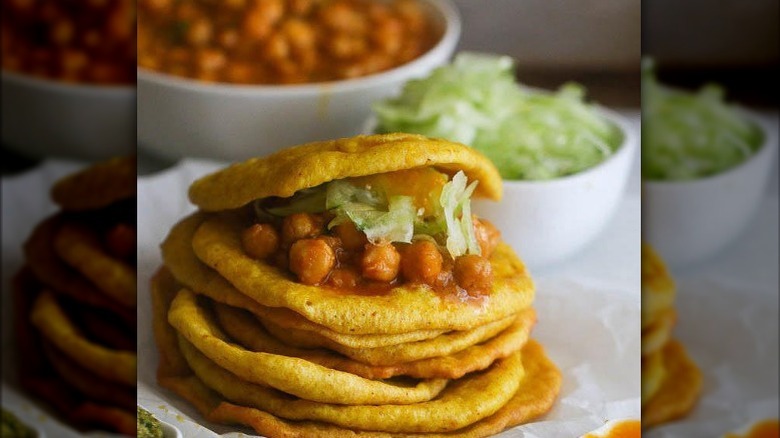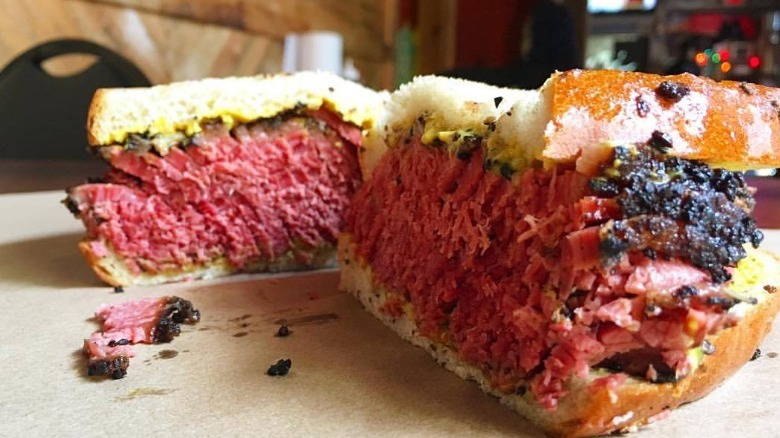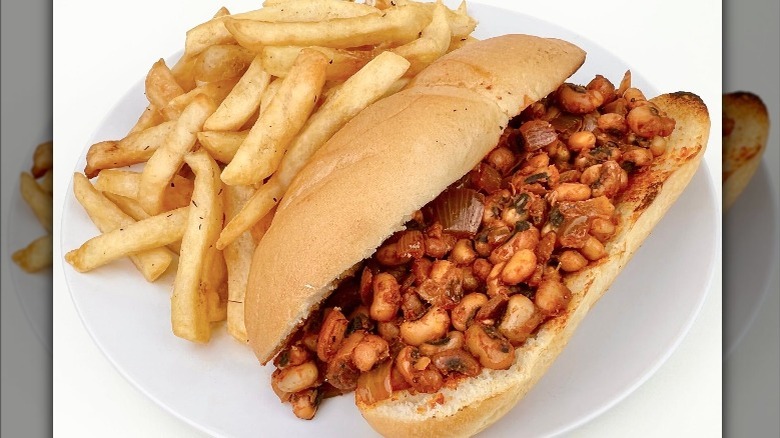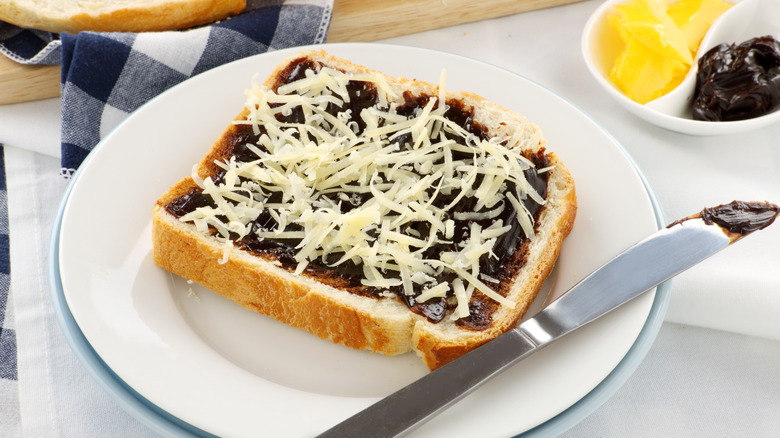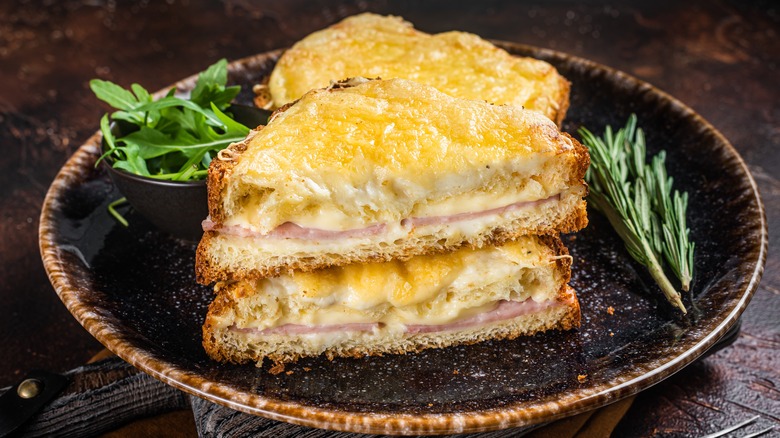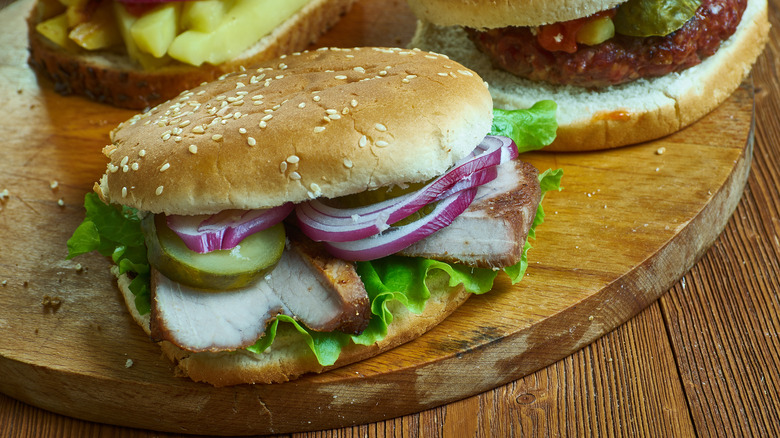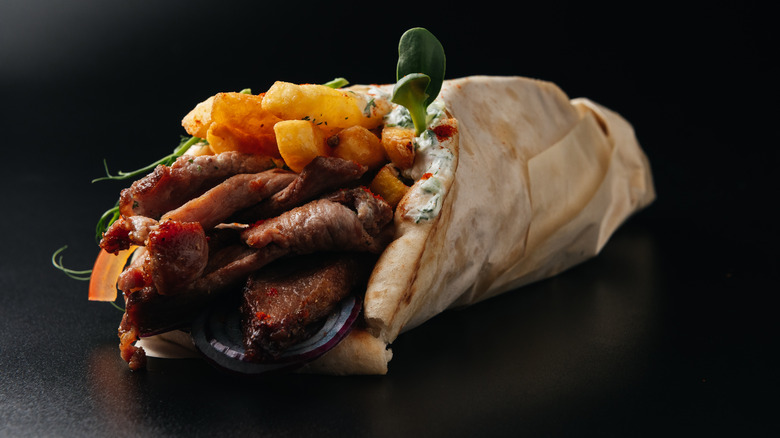How Sandwiches Are Enjoyed Around The World
Sandwiches might be the world's most perfect food. The ideal sandwich is a glorious union of soft, crispy, or hearty bread, rich fillings, bright sauces, and usually fresh vegetables that tie the whole thing together. Sandwiches are versatile, portable, and the ultimate pick-me-up meal, whether you're grabbing a quick sammie for the road or sitting down to a saucy wonder that you can devour with a knife, fork, and stack of napkins.
No matter where you go on the planet, there's bound to be a mouthwatering local sandwich that you can sink your teeth into. From decadent vegetarian favorites and meaty soft steamed buns to over-the-top French-fry-filled beauties, there's a sandwich for every taste. Can't hop on a plane to sample authentic Croquette Sando? The United States is full of great sammies, too. But, if you do find yourself on the streets of Hanoi or Paris, make sure that you get your hands on one of these must-devour sandwiches.
Vietnam: Bánh mì
This traditional Vietnamese breakfast sandwich jam-packed with meat, veggies, fresh herbs, and seasoning is now a global phenomenon (via Vietnam Times), a glorious marriage of French and Vietnamese cuisine served on a crusty, hearty French baguette. Although there are endless variations of bánh mì sandwiches, the basic formula is the same, with meat and tart pickled veggies taking center stage.
Take one bite of this hearty and tasty dish, and you'll understand why many people consider it to be one of the greatest sandwiches of all time. While you can undoubtedly stroll the streets of Hanoi or Saigon and find tons of vendors selling their version of bánh mì, you can save yourself the plane ticket and find a tasty rendition closer to home. Waves of Vietnamese people moved to the United States after the Vietnam War, bringing this beautiful baguette sandwich with them (via BBC).
Turkey/Global: Döner kebab
While the Turks get credit for dreaming up the first renditions of döner kebab centuries ago, the sandwich version is actually more of a global collaboration. As with many amazing foods, its origins are slightly murky, with some debate as to whether Kadir Nurman or Mehmet Aygün first fused tender, seasoned döner meat with bread in early 1970s Berlin, or even if the sandwich existed slightly earlier in London (via The Guardian).
However döner kebab came to be, it's hard to deny the utter deliciousness and decadence of this happy union of slow-cooked marinated meat, tangy yogurt, thinly-sliced vegetables, and soft bread. Döner's meat is roasted on a vertical spit that slowly spins to give the meat a uniform and perfectly cooked taste. Kebab sellers shave off thin slices and then pile them high for the ultimate, savory street food snack.
Isreal: Sabich
According to Special Broadcasting Service (SBS), Isreal's yummy contribution to the wonderful world of global sandwiches has Iraqi roots, thanks to Jewish immigrants from Iraq who introduced the sandwich in the mid-1900s. Sabiches are simple and hearty sandwiches with cold-cooked eggplant, potatoes, and eggs served in pita bread. Sabiches are traditional Shabbat food (via SBS), as all of the ingredients are cooked in advance and merely assembled to eat. Cooking is forbidden on Shabbat (via Chabad.org).
The combination of robust, rich, meaty eggplant, eggs, fresh veggies, and cold cooked potatoes is as filling as it is delicious. In addition to being exceptional Shabbat fare, sabiches are great for camping trips, packed lunches, and long trips thanks to their filling nature and tastiness, even when cold or at room temperature. Although you'll find plenty of authentic sabiches in Tel Aviv, you can create your own at home with a few simple ingredients and vegetables.
Cuba: Cuban sandwich
The beloved Cuban sandwich is nearly ubiquitous in the southern part of Florida, with roots in Havana (via Steemit). According to Flamingo Magazine, Cuban sandwiches may have been created in some form by the Taíno, Cuba's native people, when they topped flatbread with meat and made the first version of the sandwich. Cuban sandwiches hit Key West in the mid-1800s and evolved into their current form, a scrumptious mixture of cheese and ham (via Flamingo Magazine).
Today's Cuban sandwiches are flat-pressed savory gems full of gooey Swiss cheese, ham, and tender pork. They get their signature crunch from tart pickles and a smear of spicy mustard. The whole lovely sandwich is pressed thin and served hot. Fortunately, there are plenty of great places to get your Cuban sandwich fix in the United States, offering both traditional sammies and slight variations and riffs on the original recipe.
Japan: Croquette sando
According to Departures, the first sandos appeared in Japan during the 16th century, thanks to Dutch and Portuguese influences and increased trading. Although they fell off the map briefly in 1630, they re-emerged in various forms until the 1870s, when yeasty, soft, delicious sandos first began appearing. Those original sandos were filled with everything from bean paste to sweet cream — and eventually, the croquette sando landed on the scene.
The Japanese croquette sando is a savory symphony of different textures and flavors. The croquette is the star, a rich meaty, potato-heavy deep-fried flavor bomb placed in the center of airy sando bread and drizzled with tonkatsu sauce, a tomato, and plum-based Japanese sauce with a bright hit of vinegar and citrus (via Planted). Thinly sliced cabbage completes the meal and adds a fresh twist to the croquette sando, making it easily one of Japan's best street food dishes.
Isreal/Palestine: Falafel
According to the New York Times, falafel is a contentious issue between Palestinians and Israelis, with the former claiming that the latter stole the crispy, spicy chickpea creation. However, if you dig a little bit deeper, you'll find that falafel probably first popped up in Egypt (via History Today), although the timeline is particularly murky. Falafel's mysterious and fiercely debated origin story aside, its near-universal deliciousness is not up for debate. The falafel sandwich is a glorious mixture of savory falafel, tangy sauce, crisp vegetables, and pita bread.
Although authentic falafel differs from western versions, there are still many places to get your falafel fix in the United States. Full of robust, aromatic spices like warm cumin and coriander, these chickpea balls are a unique meat-free alternative full of protein and nutrients (via Healthline). Then, top your falafel sandwich with a nutty, aromatic drizzle of tahini (via Spiceography), and you have a flavorful, complex, and healthfully decadent meal.
South Africa: Gatsby sandwich
South Africa's Gatsby sandwich is a hedonistic behemoth bursting with virtually every ingredient that you can think of and is easily enough to feed several hungry people. The giant Gatsby was born in Cape Town and quickly spread throughout the region (via BBC). As with Buffalo wings (via Time), Gatsby sandwiches are the result of a happy accident — Rashaad Pandy of Super Fisheries concocted the great sandwich out of refrigerator leftovers (via BBC).
Faced with hungry guests and no conventional sandwich fixings in sight, Pandy cobbled together a masterpiece of French fries, various meats, pickled vegetables, and tons of sauce. Although the Gatsby was initially served on a circular roll, it eventually evolved into a massive submarine sandwich fit for several diners. Today's Gatsby sandwiches are crammed with cheeses, veggies, meat, crisp French fries, and tons of different sauces, rendering the term "feast" an understatement.
Uruguay: Chivito
Although Chivito sandwiches are a famous and beloved food across the South American country today, they actually started off as a practical joke (via SC Times). It all started with a hungry customer looking for a goat meat sandwich back in 1944. Antonio Carbonaro, an innovative restaurateur, dug through this refrigerator and fished out various meats, butter, and a few condiments (via Guru Guay), creating the immortal Chivito sandwich.
According to Taste Atlas, Chivito sandwiches are Uruguay's national dish. It's easy to understand how this hearty sandwich made its way into hearts across the country, with its tender layers of thin steak, ham, bacon, egg, cheese, and vegetables. It's got tons of different textures, brightness and tartness from the chopped veggies, and richness from the perfectly-cooked steak. Plus, true Chivito connoisseurs know that the best way to eat it is with ketchup and mayonnaise dipping sauce (via SC Times).
India: Bombay sandwich
India's Bombay sandwich is a legendary street food with utterly simple ingredients that simply sing when you put them together. Like many cherished foods, the origins of the Bombay sandwich are highly contested (via CN Traveller). At its core, the Bombay sandwich is white bread filled with chutney, vegetables, butter, and potatoes. Different variations contain cheese, mashed potatoes, or additional vegetables (via The Guardian), making this sandwich one that you can customize lavishly to your heart's content or enjoy plain.
Although simple, the key to the Bombay sandwich's success lies in the contrast of its ingredients. Green chutney is bright and herbaceous, the perfect foil for richer potatoes and vegetables. The butter adds a burst of fat and blends beautifully with the white bread, offsetting the chutney and potatoes and tying everything in together. Finally, the bread itself is the perfect width for the rest of the ingredients.
Malaysia/Singapore: Roti john
According to Time Out, roti john has a few distinct origin stories, but what ties them together is the commonality of the name. Whether you believe that roti john dates back to the 1960s in Malaysia, or Singapore, the dish's name comes from a desire to sell food to white visitors or service people in the two countries. "John" was a popular moniker for white people, so the dish's name translates to "bread, John?"
As with many great sandwiches, roti john hits on the trifecta of good tastes; spicy, meaty, and cheesy. It's a beautiful combination of heaping diced meats, eggs, and vegetables, all covered in twin drizzles of cheese and chili sauces. You'll get a mouthful of everything in each bite. However, unlike other substandard submarine sandwiches, the bread doesn't overwhelm any of the fillings. Instead, roti john hits the bread-to-filling ratio perfectly, which is probably why it's still wildly popular today.
Denmark: Smørrebrød
Smørrebrød, Denmark's famously versatile and delicious open-faced sandwich, came about thanks to local farmers wanting a portable and easy way to take their lunch to work. According to Scandinavia Travel, these farmers loaded up bread with remnants of the last evening's dinner, using the bread for practical purposes rather than the sandwich itself. As smørrebrød evolved, the bread became part of the overall dish, and people started making it for at-home as well as on the road meals.
Smørrebrød refers to a vast array of open-faced sandwiches, but there are some pretty standard ingredients, like smoked salmon, dill, and horseradish sauce. The basic structure seems to include a smear of creamy spread, meats or fish, and some lightly chopped herbs, although adventurous eaters can always brighten their smørrebrød with crispy apples, nuts, or a variety of different meats.
Taiwan: Gua bao
Taiwanese gua bao combines soft, tender steamed buns with pork belly and assorted fillings for a tasty street snack that hits all the right flavor notes and is guaranteed to satisfy your hunger within minutes. According to CNN, gua bao (which it calls "Taiwan's hamburger") is one of Taiwan's most authentic and traditional street foods containing a tart punch of pickled veggies, spices, and plenty of slowly cooked pork. Traditionally eaten during the Taiwanese celebration of Weiya, it's meant to symbolize a fresh start.
Even if you don't celebrate Weiya and aren't interested in erasing back luck off your slate, you can still enjoy gua bao, whether at a restaurant or in your own home. These sandwiches are unique little bites that get much of their crunch and texture from the veggies and fork-tender pork inside, with the airy, doughy buns acting as the ideal canvas for the other exceptional flavors.
Trinidad: Doubles
Doubles are a Trinidadian street food full of tangy, sour tamarind, rich coriander, sweet and spicy chutney, hearty chickpeas, and a lot of crunchy cucumber, all piled into crispy fried bread and served hot. According to the BBC, the chickpea filling is slow-cooked in flavorful curry, and the bright veggies and sauces play off their richness nicely, hitting all of the taste notes in a savory vegetarian flavor burst.
Trinidadians enjoy this snack any time of the day, and it's a hearty and nutritious remedy after a long night out or simply a substantial breakfast on the go for busy people (via BBC). Like all exceptional global sandwiches, the secret sauce to doubles' success is in the contrast of textures and flavors, plus the filling mixture that keeps you satisfied for the long run. It's also a welcome change from meat-filled, cheese-packed sammies and a true omnivore treat.
Canada: Montréal smoked meat
The first rule of enjoying Montréal smoked meat is not to confuse it with pastrami, New York's saltier and sugary cousin that bears a passing resemblance. Montréal smoked meat is cooked in water for a slightly different taste and texture (via The Globe and Mail), making its consistency more like that of corned beef. According to Tourisme Montreal, this gargantuan, meaty sandwich may have Jewish Eastern European roots and first appeared in Montréal around the turn of the 1900s, courtesy of Lithuanian immigrants.
Today, it's an iconic Canadian food whose infamy is right up there with poutine. To make the perfect Montréal smoked meat sandwich, you need stacks of slowly cooked and smoked brisket nestled between two slices of bread. Sharp mustard and a tangy pickle cut through the fat and give the sandwich another element of flavor, rendering these bulky sandwiches one for the ages.
Senegal: Ndambe
For a vegetarian, healthy sandwich full of flavor that will satisfy those hunger pangs for the long run, there are very few contenders, with Ndambe being one of the best. This Senegalese sammie is one of the most popular treats in the country, and you can find it everywhere in Dakar. It's perfect for a mid-day snack or casual lunch or dinner on the go.
According to the Atlanta Journal-Constitution, the ingredients are relatively simple. Well-cooked peas make up the base, along with starchy yucca and spice. If you want to recreate this hearty vegetarian sandwich at home, you can always swap out the yucca for extra sweet potato, which will bulk up the filling and still give you the original flavor integrity of the dish. Pop all of that good stuff into a thick roll, serve it all up with a side of crispy French fries, and you're ready to chow down.
Australia: Vegemite
Vegemite is a fairly polarizing food, and while many Australians love the thick deep black spread, non-Aussies can't seem to stand the stuff (via VICE). Although the idea of a Vegemite sandwich can be intimidating, it's worth giving this malty spread a try, at least to say that you've done it. According to the National Museum of Australia, Vegemite came about almost 100 years ago as Australia's answer to Marmite, and its popularity exploded during the Second World War.
Vegemite might have been invented as the Aussie clap-back to Marmite, but they are not the same. Marmite is sweeter and gooier than Vegemite, whereas the latter has bitter notes and a rich umami flavoring. You might be able to snag yourself some Vegemite in shops from Brisbane to Sydney, but there's one place that Australians can't get their hands on it: prison. Instead of spreading Vegemite on their toast, Australian inmates made it into jailhouse booze.
France: Croque monsieur
France's croque monsieur is a wonderful marriage of thinly-sliced ham and plenty of premium cheese. Toast it up, and you have a hot and fresh French snack or light meal with a meaty and cheesy interior and crispy exterior. The combination of tastes and textures is one for the record books, with is probably why the croque monsieur is one of France's top sandwiches. According to Traveller, the croque monsieur dates back at least 100 years. However, its exact origin story is a bit murky, from a brassieres' substitution of sandwich bread for baguettes to a happy mishap with a too-hot radiator.
Today, you can get your croque monsieur the traditional way with tons of ham and cheese crammed between two pressed and toasty slices of bread, or you can transform it into a croque madame by simply adding a fried egg on top. The fried egg adds more salt, fat, and gooiness to the sandwich, and is a great way to enjoy your Croque if you have a knife, fork, and plenty of napkins handy.
Peru: Butifarra sandwich
Don't make the rookie mistake of referring to Peru's butifarra as simply a ham sandwich. This iconic treat is more than that, with deeply-spiced ham, tons of peppers and onions, and fresh-from-the-oven bread (via Eat Peru). It's the ultimate example of how stellar ingredients can take even a fairly ordinary sandwich combination to dazzling new levels. You can find it all over Peru, from Lima to Arequipa.
According to Eat Peru, the sandwich's central ingredient is ham, and it's what makes Butifarra extraordinary. The ham, also known as jamon del pais, is made from local pork and liberally spiced with tons of garlic, peppers, and a slathering of oil. Then, it's slow-cooked, sliced up, and served for a juicy portion of meat in every single bite. Although you can recreate butifarra at home with good ingredients and super-fresh bread, it's unlikely that you'll be able to score the central player in the dish. For true butifarra, you might have to hop on a plane to the Sacred Valley.
Greece/Global: gyro
We can most likely thank the Greeks for introducing the world to the modern version of gyros (via the New York Times), although some accounts counter that gyros are actually Persian or creations of the Ottoman Empire. Whether today's version of this meaty sandwich originated in the sun-drenched Mediterranean country of Greece, ancient Persia, or the Ottoman Empire, it was perfected and mass-produced less than a century ago.
Some say that George Apostolou began the gyro boom in the United States in the 1960s (per the New York Times) by mass-producing the sandwiches and sandwich meat, but there are as many versions of the origin story as there are toppings to crown your gyro with. Gyros are the inspired combination of thinly sliced, slow-cooked meat, vegetables, and sauce stuffed into a lightly toasted pita. Wherever you live, there's probably a gyro joint near you, or you can make one at home with this recipe.
